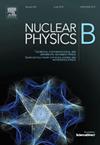Effect of backreaction on island, Page curve and mutual information
IF 2.5
3区 物理与天体物理
Q2 PHYSICS, PARTICLES & FIELDS
引用次数: 0
Abstract
We compute the entanglement entropy of Hawking radiation in a bath attached to a deformed eternal AdS black hole. This black hole is dual to the two identical strongly coupled large- thermal field theories, where each theory is backreacted (deformed) by the presence of a uniform static distribution of heavy fundamental quarks. In our observation we find that the entanglement entropy of Hawking radiation increases in a quadratic manner for an early time and linearly for the late time. The large time expression for the entanglement entropy of Hawking radiation is used to find the Page curve and Page time. After the Page time, the entanglement entropy saturates to a constant value due to the appearance of an island. We observe that introducing deformation (backreaction) delays the appearance of island and shifts the Page curve to a later time. Subsequently, the computation of the scrambling time reveals an increase with the backreaction parameter, suggesting a longer duration for information retrieval in the presence of deformation. Moreover, our analysis of the mutual information between the radiation subsystems shows that it vanishes at a critical time which increases with the deformation before the Page time. After the Page time, the appearance of island leads to the vanishing of mutual information between black hole subsystems and gives the time difference of the order of scrambling time.
反作用对孤岛、Page曲线和互信息的影响
我们计算了霍金辐射的纠缠熵,该纠缠熵与一个变形的永恒的AdS黑洞相连。这个黑洞是两个相同的强耦合大nc热场理论的对偶,其中每个理论都被重基本夸克均匀静态分布的存在反反应(变形)。在我们的观察中,我们发现霍金辐射的纠缠熵在早期以二次方式增加,在后期以线性方式增加。利用霍金辐射纠缠熵的大时间表达式求出Page曲线和Page时间。在Page时间之后,由于出现孤岛,纠缠熵饱和到一个恒定值。我们观察到,引入变形(反作用力)延迟了岛的出现,并将Page曲线移动到较晚的时间。随后,加扰时间的计算随着反作用力参数的增大而增大,表明变形存在时信息检索所需的时间更长。此外,我们对辐射子系统之间的互信息进行了分析,发现它在一个关键时刻消失,并随着页前变形的增加而增加。在Page时间之后,孤岛的出现导致了黑洞子系统之间互信息的消失,并给出了置乱时间阶的时间差。
本文章由计算机程序翻译,如有差异,请以英文原文为准。
求助全文
约1分钟内获得全文
求助全文
来源期刊

Nuclear Physics B
物理-物理:粒子与场物理
CiteScore
5.50
自引率
7.10%
发文量
302
审稿时长
1 months
期刊介绍:
Nuclear Physics B focuses on the domain of high energy physics, quantum field theory, statistical systems, and mathematical physics, and includes four main sections: high energy physics - phenomenology, high energy physics - theory, high energy physics - experiment, and quantum field theory, statistical systems, and mathematical physics. The emphasis is on original research papers (Frontiers Articles or Full Length Articles), but Review Articles are also welcome.
 求助内容:
求助内容: 应助结果提醒方式:
应助结果提醒方式:


